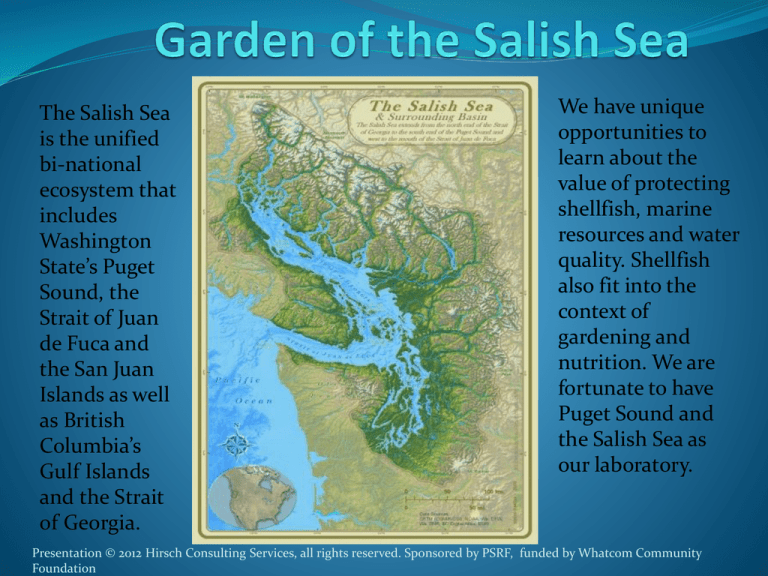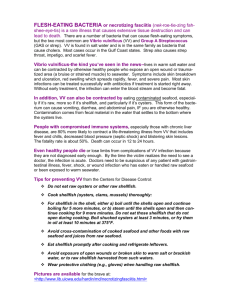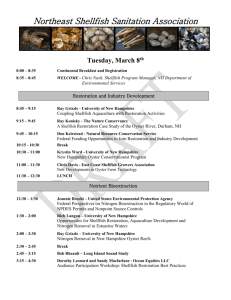
The Salish Sea
is the unified
bi-national
ecosystem that
includes
Washington
State’s Puget
Sound, the
Strait of Juan
de Fuca and
the San Juan
Islands as well
as British
Columbia’s
Gulf Islands
and the Strait
of Georgia.
We have unique
opportunities to
learn about the
value of protecting
shellfish, marine
resources and water
quality. Shellfish
also fit into the
context of
gardening and
nutrition. We are
fortunate to have
Puget Sound and
the Salish Sea as
our laboratory.
Presentation © 2012 Hirsch Consulting Services, all rights reserved. Sponsored by PSRF, funded by Whatcom Community
Foundation
Marine
resources are
close to
home
Drayton
HarborWatershed
© 2012 Hirsch Consulting Services, all rights reserved. Sponsored by PSRF, funded by Whatcom Community Foundation
Marine Marathon Kick-off pre-field trip presentation.
Drayton Harbor Community Oyster Farm field trip.
Field trip follow-up – share your work on the Garden of
the Salish Sea website.
Salish Sea Pledge – practice healthy watershed habits
at home.
© 2012 Hirsch Consulting Services, all rights reserved. Sponsored by PSRF, funded by Whatcom Community Foundation
SHELLFISH
Giant clam
Tridacna
clam
Cockscomb oyster
Rough file clam
Come
in all
shapes,
colors
and
sizes!
Geoduck clam-Panopea generosa the largest burrowing clam
can reach 8 lbs and live more than 150 years.
Manila clam-Venerupis philippinarum
introduced from Japan.
Pacific oyster Crassostrea gigas,
introduced from Japan.
Olympia oyster - Ostrea lurida is
the only oyster native to Puget
Sound. It’s populations are
threatened.
Shellfish are
important for
a lot of
reasons…
They are
keystone
species..
They tell us about the past.
They provide habitat.
They clean our waters.
They are economically
important.
They are nutritious…. IF…
If we keep our
waters clean!
© 2012 Hirsch Consulting Services, all rights reserved. Sponsored by PSRF,
funded by Whatcom Community Foundation
Photo by Geoff Menzies
Evolutionary tree
Cast of
characters
1st photosynthesis
3.4 billion yrs ago…
Bacteria 3.8 billion yrs ago……
People too!
….570 million yrs ago
Shellfish
classification
mollusk: invertebrate
with a soft
unsegmented body
usually enclosed in a
shell, or exoskeleton.
Pacific oyster
Kingdom: Animalia
Phylum: Mollusca
Class: Bivalvia
Order: Ostreoida
Family: Ostreidae
Genus: Crassostrea
Species: C. gigas
Binomial name
Crassostrea gigas
Manila clam
Kingdom: Animalia
Phylum: Mollusca
Class: Bivalvia
Subclass: Heterodonta
Order: Veneroida
Suborder: Cephalaspidea
Superfamily: Veneroidea
Family: Veneridae
Genus: Venerupis
Species: V. philippinarum
A shell midden
is a heap of
clam, oyster, or
mussel shells
where people
lived or camped
that can date
back to the
Stone Age. They
are clues to how
and where
groups of people
lived.
© 2012 Hirsch Consulting Services, all rights reserved. Sponsored by PSRF,
funded by Whatcom Community Foundation
Photo public
domain
Coast Salish Culture
Shellfish are an important
part of Native-American
culture. Coast Salish people
have harvested shellfish
historically for food, used
shells for tools and in
ceremony for thousands of
years.
Hoe blade
Fishing net weights
Fossils are the remains
of buried prehistoric
organisms like shellfish.
They record the history
of life from about 3.5
billion years ago .
Shell fossils tell us about
extinct species and where
there were prehistoric
oceans.
Hey that’s the study
of paleontology!
Hirsch Consulting Services and PSRF - Funded by
Whatcom Community Foundation
Each shellfish
can filter up to 65
gallons per day!
Photo by PCSGA
Life Cycle
Adult oysters begin reproduction
when water temperatures become
greater than 68�F (~20�C). This
generally occurs from May through
October. Oysters are broadcast
spawners, meaning they release
eggs and sperm into the water
column. A fertilized egg develops
into a planktonic (free-swimming)
trochophore larva in about 6 hours.
A fully shelled veliger larva is
formed within 12 to 24 hours. The
larva remains planktonic for about
three weeks. Towards the end of this
period it develops a foot (hence,
pediveliger) and settles to the
bottom of the water column where
it seeks a hard substrate. When a
suitable surface (ideally adult oyster
shell) is located, the larva cements
itself and metamorphoses to the
adult form. This newly attached
oyster is known as a "spat."
Shellfish at risk: Puget Sound becoming acidified
The waters of Puget Sound and Hood Canal are becoming more acidified as a result of
rising carbon dioxide from industries, power plants and vehicles. Scientists from the
University of Washington and the National Oceanic and Atmospheric Administration
warn that the shifting water chemistry could damage the region's shellfish industry.
Seattle Times article June, 14 2010.
Proc Natl Acad Sci U S A. 2010 October 5;
107(40):
Atmospheric carbon dioxide
dissolves in seawater, producing
acids that raise the water's
corrosiveness. As seawater
becomes more corrosive, below
8.0, it can dissolve the shells of
small crustaceans, baby
shellfish, and other tiny
creatures at the base of the food
web. Among the hardest hit:
oyster larvae.
Hirsch Consulting Services and PSRF - Funded by Whatcom Community
Foundation
Shellfish Food
Chain
© 2012 Hirsch Consulting Services, all rights reserved. Sponsored by PSRF, funded by Whatcom Community Foundation
Oysters are extremely important because they filter nutrients
out of the water and convert them into a local protein source or
make them available for uptake by other species such as eelgrass.
Hirsch Consulting Services and PSRF - Funded by
Whatcom Community Foundation
Even humans?
Yep, us too.
Fecal coliform bacteria live in
the guts of warm blooded
animals ,
(like some disease causing
organisms or pathogens).
They are water quality indicators. Fecal
coliform bacteria can indicate the presence
of some pathogens like E.coli. Too much =
pollution!
Hirsch Consulting Services and PSRF - Funded by Whatcom Community Foundation
1 gram of dog feces
contains 23 million
fecal coliform
bacteria- thats 1.1
billion per pound!
That’s the
straight poop!
Proteobacteria
Escherichia coli
Scientific classification
Domain:
Bacteria
Phylum:
Proteobacteria
Stackebrandt et al., 1988 [1]
Hirsch Consulting Services and PSRF - Funded by
Whatcom Community Foundation
Hirsch Consulting Services and PSRF - Funded by
Whatcom Community Foundation
Heaven on the half-shell
Shellfish are good for you!
Low in fat
Rich in Omega-3 fatty acids
High in protein
“BRAIN FOOD”, rich in amino acids used by your brain
High in minerals like iron and zinc for healthy blood
and immune systems.
*Some people have allergies to shellfish
We are what
we eat!
In the Pacific
Northwest, the
shellfish industry
injects an estimated
$270 million a year into
the region’s economy,
bringing jobs to over
3,200 people (NOAA,
2012)
Pick-up your
pet’s waste!
Keep shellfish
safe to eat!
Don’t release
your boat’s
holding tank
into the
water!
Maintain your
septic
system!
Keep
livestock out
of creeks!
© 2012 Hirsch Consulting Services, all rights reserved. Sponsored by PSRF, funded by Whatcom Community Foundation
Shellfish Vocabulary
Filter feeder-Animals like clams and oysters that feed by straining often
microscopic food particles from water.
Plankton-Greek for drifter, microscopic plants, animals or bacteria that are
carried with the current. They provide a crucial source of food to larger
organisms.
Zooplankton-Tiny free floating animals.
Phytoplankton-Microscopic drifting plants.
Fecal bacteria – Bacteria from the gut of warm blooded animals that can
indicate the presences of pathogens, other bacteria that can cause disease.
Photosynthesis-Process used by plants to make food from light and carbon
dioxide in the air, with oxygen as a bi-product.
Mollusk-A soft bodied invertebrate like clams and oysters.
Bivalve-A mollusk with two hinged shells, such as a scallop, clam, mussel or
oyster.
Ocean acidification – Too much carbon dioxide is absorbed by oceans which
makes them more acidic and can prevent shellfish larvae from forming their
shells.
Spat- A juvenile oyster that has undergone metamorphosis, develops its shell
and attaches to substrate.
© 2012 Hirsch Consulting Services, all rights reserved. Sponsored by PSRF, funded by Whatcom Community Foundation



